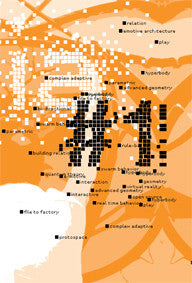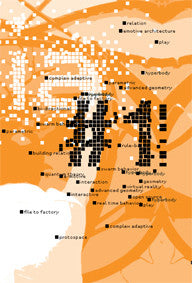Your cart is currently empty!
Theorie
iA#1 - Interactive Architecture
+++ +++
+++Kas Oosterhuis, Xin Xia [red.]+++
978-90-5973-058-8 [episode]
Danielle van Steenbergen, Xin Xia
96
21 x 12
Paperback
Engelstalig
Een nieuw serie over interactieve architectuur
Deze iA-bookazine serie zal bestaan uit twaalf delen gepubliceerd over een periode van zes jaar onder de supervisie van prof. ir. Kas Oosterhuis, directeur van Hyperbody aan de Faculteit Bouwkunde, Technische Universiteit Delft, en directeur van ONL [Oosterhuis_Lénárd] bv.
Ieder deel van de iA-serie zal bestaan uit wetenschappelijke papers over een afzonderlijke aspect van interactieve architectuur, MSc-projecten, case studies, workshops, studentenprojecten, interviews met gerenommeerde onderzoekers, ontwerpers en architecten, en een blog door Kas Oosterhuis, interessante links en aanverwante artikelen.
Kas Oosterhuis (hoofdredacteur - iA)
'What is Interactive Architecture? Let me first clarify what it is not. Interactive Architecture - from here on abbreviated as iA - is not simply architecture that is responsive or adaptive to changing circumstances. On the contrary, iA is based on the concept of bi-directional communication, which requires two active parties. Naturally, communication between two people is interactive; they both listen [input], think [process] and talk [output]. But iA is not about communication between people, it is first defined as the art of building relationships between built components and second, as building relations between people and built components.'
In dit eerste deel van iA zijn bijdragen opgenomen van Cas Aalbers, Ayssar Arida, Henriette Bier, Nimish Biloria, Michael Bitterman, Sven Blokker, Sander Boer, Lukas Feireiss, Christian Friedrich, Hans Hubers, Tomasz Jaskiewicz, Chris Kievid, Kas Oosterhuis, Dominik Otto, Dimitris Theocharoudis en Xin Xia.
€18.00
iA#1 - Interactive Architecture
€18.00
Architectuur / Bookazines / serie / Vormgeving / Theorie
978-90-5973-058-8 [episode]
Danielle van Steenbergen, Xin Xia
96
21 x 12
Paperback
Engelstalig
Een nieuw serie over interactieve architectuur
Deze iA-bookazine serie zal bestaan uit twaalf delen gepubliceerd over een periode van zes jaar onder de supervisie van prof. ir. Kas Oosterhuis, directeur van Hyperbody aan de Faculteit Bouwkunde, Technische Universiteit Delft, en directeur van ONL [Oosterhuis_Lénárd] bv.
Ieder deel van de iA-serie zal bestaan uit wetenschappelijke papers over een afzonderlijke aspect van interactieve architectuur, MSc-projecten, case studies, workshops, studentenprojecten, interviews met gerenommeerde onderzoekers, ontwerpers en architecten, en een blog door Kas Oosterhuis, interessante links en aanverwante artikelen.
Kas Oosterhuis (hoofdredacteur - iA)
'What is Interactive Architecture? Let me first clarify what it is not. Interactive Architecture - from here on abbreviated as iA - is not simply architecture that is responsive or adaptive to changing circumstances. On the contrary, iA is based on the concept of bi-directional communication, which requires two active parties. Naturally, communication between two people is interactive; they both listen [input], think [process] and talk [output]. But iA is not about communication between people, it is first defined as the art of building relationships between built components and second, as building relations between people and built components.'
In dit eerste deel van iA zijn bijdragen opgenomen van Cas Aalbers, Ayssar Arida, Henriette Bier, Nimish Biloria, Michael Bitterman, Sven Blokker, Sander Boer, Lukas Feireiss, Christian Friedrich, Hans Hubers, Tomasz Jaskiewicz, Chris Kievid, Kas Oosterhuis, Dominik Otto, Dimitris Theocharoudis en Xin Xia.



